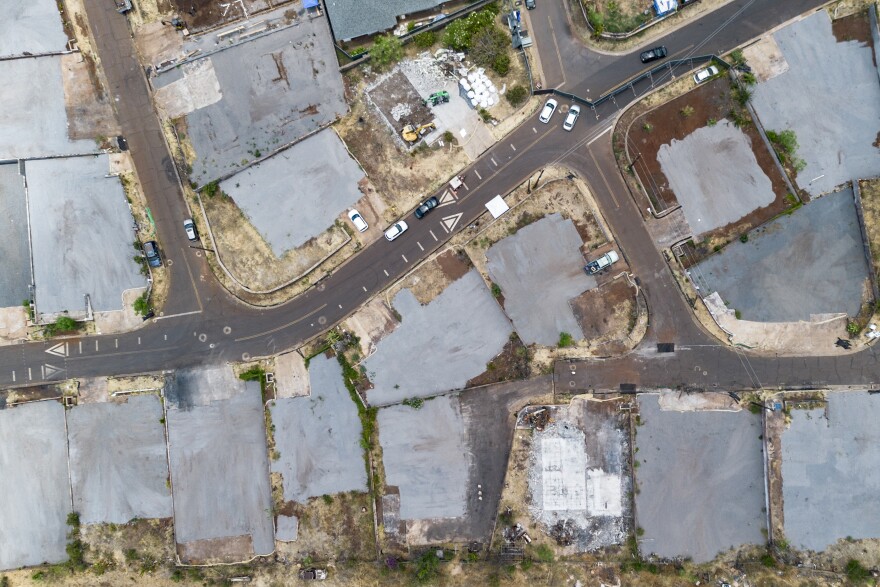If all goes as planned, $1.6 billion in recovery funding from the U.S. Department of Housing and Urban Development will help the Lahaina community get back on its feet. It’s known as Community Development Block Grant Disaster Recovery funding, and it comes with strict requirements.
“It's intended for vulnerable communities. It's intended for low-to-moderate income,” said Mayor Richard Bissen at a community meeting this week about the county’s plans for the CDBG-DR funding.
HUD defines the low-to-moderate income guidelines as those having an annual income of less than 80% of an area’s median income.
“We have about $7.7 billion of damage that occurred out in Lahaina, and we did receive some funds to maybe bring that down a little bit,” Bissen explained. “However, we have over $6 billion remaining in unmet needs, and so these funds are intended to help us get to our recovery.”
A majority of it — more than $900 million — is earmarked for housing. The funds will rebuild qualified single-family homes destroyed in the fire through an application process. It will also reconstruct some multi-family rental housing and new housing to give displaced former renters a chance at home ownership.
Other programs include critical infrastructure repairs and upgrades, fire mitigation efforts, and public services such as health care resources, job training and case management support.
John Smith of Maui County’s Office of Recovery said funds are expected to be available this summer, and implementation will begin in the fall.
“We actually are on a timeline from HUD,” he explained. “So it may feel like this is moving really fast, but we want to move fast, because the faster we move, the faster that we actually are able to get funding to you folks.”
The first $82 million for administrative costs is already on its way to being released. County officials say they’re working closely with HUD staff and are confident that federal cuts will not affect the rest of the funding authorized by Congress.
Bissen says they have asked the Maui County Council to amend this year’s budget and accept the entire CDBG-DR amount this year to expedite funds.
“We have the support of the HUD staff that we're working with right now,” he explained. “So I think they're also encouraging us now. Of course, if we don't move quick enough, and we don't receive the funds, and they decide to change, I believe we will have the right to appeal those kinds of decisions in the courts… because this was a congressional order. This didn't come from the administration, this came from Congress who authorized [the CDBG-DR funds].”
How does resident feedback factor into the plan?
Community organizations have been rallying residents to offer input on the plan.
Eric Arquero is executive director of Kaibigan ng Lahaina, working to address the needs of the large Filipino community affected by the fires. The nonprofit surveyed more than 120 households representing the 4,000 impacted Filipino Lahaina residents to better inform the CDBG-DR planning process.
“I think the survey really highlighted primarily that there is a need for rental inventory that's occurring concurrently with owner-occupied rebuilds.”
Arquero says more than 70% of survey respondents were renters prior to the fire, yet he notices a recovery focus on rebuilding owner-occupied homes.
“I think there's a bit of a fear that if things are not being rebuilt to address the larger population of renters in Lahaina, a lot of people may have to make a difficult decision to relocate.”
Autumn Ness of the Lahaina Community Land Trust worries Lahaina families might experience long-term displacement from the homes built with the disaster funding. It’s a scenario she’s seen in other communities on the continent.
“We can, right now, put guardrails on that money that says we're going to rebuild these homes for our current longtime Lahaina families, and while we're at it, we're going to put these homes into an inventory of residential properties that are not ever going to be accessible to investors or Airbnb operators,” she said.
County officials say they’re working with HUD on language that could protect portions of housing from this scenario.
Some fire survivors say they just barely exceed HUD income limits for the funding but struggle to hold down multiple jobs to pay their expenses.
Bissen urges those who may not qualify for this funding to keep going.
“Please don't give up hope,” he said. “There are other programs, other funding that we are actively seeking.”
Smith reminds the community that this particular funding can only go so far.
“I think generally, when you hear the $1.6 billion number, it's like, ‘Oh, that can solve everything.’ But the reality of it is, it really can't. So we have to be disciplined in how we apply this to housing.”
The third public hearing on the county’s CDBG-DR Action Plan will be held on Friday, March 14 at 5:30 p.m. at the Cameron Center in Wailuku.
Community members have until March 26 to submit feedback online or by email.







